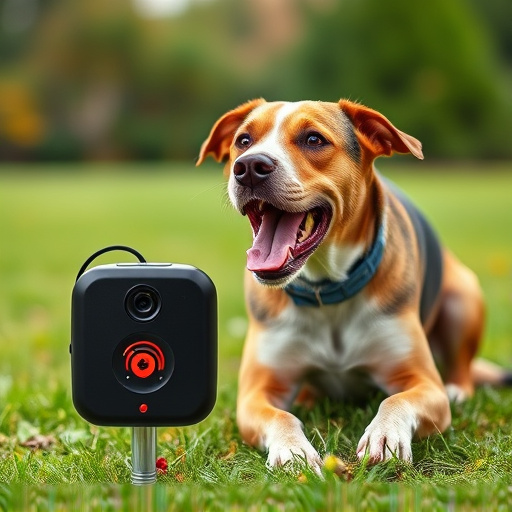Introducing our comprehensive guide to innovative bark control devices, designed to address diverse canine behavior needs. Understanding dog behavior is key to effective training. This article explores the science behind ultrasonic frequencies, a safe and humane approach to modifying barking. We delve into the advantages of multi-range devices, their practical applications, and ensure safety measures for harmonious human-dog coexistence. Discover how these tools can revolutionize your pet’s behavior while maintaining a peaceful environment.
- Understanding Dog Behavior and Bark Control Needs
- The Science Behind Ultrasonic Frequencies for Dogs
- Advantages of a Multi-Range Bark Control Device
- Effective Use Cases for Different Frequency Ranges
- Ensuring Safety and Human-Dog Coexistence with Ultrasonic Devices
Understanding Dog Behavior and Bark Control Needs
Dogs communicate through barks, which can be both a joyful signal or an indication of distress. Understanding dog behavior is crucial when choosing a bark control device. Different dogs have varying sensitivities and triggers; what works for one may not work for another. Safe ultrasonic frequencies are particularly effective as they are inaudible to humans but can capture a dog’s attention without causing harm. These frequencies stimulate dogs’ sensitivity to sound, teaching them alternative behaviors.
Training should always be the first line of defense; bark control devices are meant to reinforce positive training, not replace it. By understanding your dog’s specific needs and using safe ultrasonic frequencies, you can address excessive barking humanely. This approach ensures a peaceful environment for both neighbors and pets while fostering a stronger bond between owner and canine companion.
The Science Behind Ultrasonic Frequencies for Dogs
Dogs are highly sensitive to sound, and this is where ultrasonic frequencies come into play as a bark control method. These devices emit sounds at specific high-frequency ranges that humans typically can’t hear, but dogs can. The science behind it lies in the animal’s hearing capabilities, which extend further into the ultrasonic spectrum than our own. When a dog barks excessively, the device activates and releases these safe ultrasonic frequencies, creating an unpleasant yet harmless sound to deter barking. This method is effective because dogs learn to associate their barking with an unwelcome sensation, encouraging them to bark less.
The use of safe ultrasonic frequencies for dog control is a humane approach that doesn’t cause any physical harm or discomfort. These devices are designed to be selective, targeting only the canine’s hearing range, ensuring no impact on human ears or other pets. As a result, they offer a gentle yet powerful solution for managing unwanted barking, making them popular among pet owners seeking effective and harmless behavior modification tools.
Advantages of a Multi-Range Bark Control Device
A multi-range bark control device offers several advantages over traditional single-range models, primarily focusing on safety and effectiveness. By leveraging safe ultrasonic frequencies specifically tailored for dog control, these devices provide a humane alternative to shock or spray-based methods. The ability to adjust the frequency range allows for customization based on different situations and dog sizes, ensuring minimal discomfort or harm while still being highly deterring.
Moreover, multi-range bark control devices offer versatility in various environments. Whether in homes, yards, parks, or public spaces, users can select the appropriate frequency to match the setting and noise levels present. This adaptability not only enhances user experience but also improves overall effectiveness, making it a practical choice for both indoor and outdoor applications.
Effective Use Cases for Different Frequency Ranges
When considering a bark control device with multiple ranges, understanding the effective use cases for each frequency range is key to its successful implementation. Lower frequencies, typically between 200-400 Hz, are highly effective for outdoor use as they travel further and can be heard by dogs from greater distances. This makes them ideal for addressing nuisance barking in public spaces or larger properties where immediate intervention is required.
For indoor settings or more controlled environments, higher safe ultrasonic frequencies for dog control, ranging from 4000-8000 Hz, prove more suitable. These frequencies are imperceptible to human ears but elicit a strong aversion response in dogs. This range is particularly useful for managing persistent barking in apartments, homes, or other enclosed areas where the device’s activation should remain audible only to canines without disturbing humans.
Ensuring Safety and Human-Dog Coexistence with Ultrasonic Devices
When considering bark control devices, especially those that utilize ultrasonic technology across multiple ranges, ensuring safety is paramount. Ultrasonic frequencies designed for dog control should be human-safe, operating at levels above 25 kHz, well beyond the range of human hearing. These safe ultrasonic frequencies are effective in deterring dogs without causing harm or discomfort to humans living in close proximity.
Properly designed and tested devices ensure that the ultrasonic emissions remain within safe limits for both dogs and humans. This coexistence is crucial for maintaining a peaceful environment, especially in shared spaces like apartments or neighborhoods. Regular testing and adherence to safety standards guarantee that these bark control tools provide effective management while preserving the well-being of all inhabitants.
In conclusion, a multi-range bark control device equipped with safe ultrasonic frequencies offers a humane and effective solution for managing canine behavior. By tailoring specific frequency ranges to different scenarios, these devices ensure the well-being of both pets and their owners, fostering harmonious coexistence within our homes and communities. Understanding dog behavior and leveraging scientific principles behind ultrasonic technology allow us to create environments where dogs can thrive without excessive barking.
